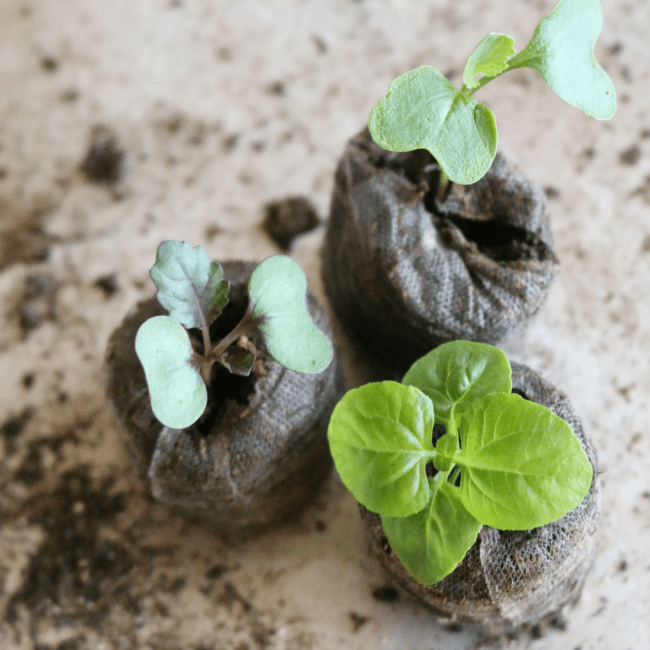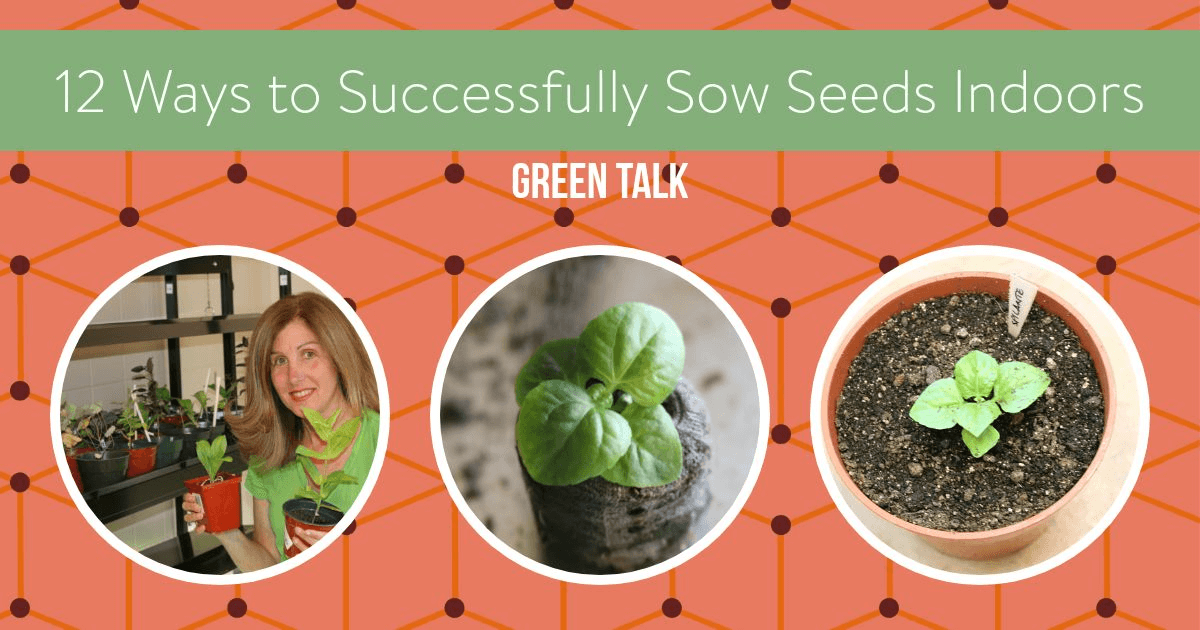.
Are you frustrated sowing seeds indoors? Maybe your seeds didn’t germinate. Or perhaps your new seedlings died before or after you planted in the garden? Here 12 way to successfully sow seeds indoors. Let’s turn that upside down frown into a smile.
Why Sow Seeds Indoors?
Before we start, you may ask, why sow seeds indoors?
I live in zone 6 (New Jersey) and don’t have a long spring or summer. So in order to harvest my plants timely, I need get a jump start by sowing seeds indoors.
You might ask, why not buy plants?
I have a variety of reasons but most importantly, it is so much cheaper to grow seeds indoors rather than buy plants at a garden store. Who wants to spend $4 a plant when you can spend $4 on a seed package of 50 seeds?
People Just Wing It and Waste Money
Sadly, most people wing it by plopping their seeds into a pot and can’t figure out why their seeds didn’t germinate. Or worse yet, they buy all the proper equipment and still fail.
Time and time again, when I attend the Philadelphia Flower Show, I listen to people as they pick up their seed packages.
This year I overheard various conversation as I browsed the seed vendors.
I got more and more frustrated since people were spending money with high hopes to only be left with seeds that didn’t germinate. Seeds are like shiny objects. You just want some.
As I continued to watch, I listened to their conversations. They picked the wrong seeds for their type of gardens, wanted to grow certain seeds in pots which would clearly take over the pot and some didn’t know which seeds worked in their garden.
Trust me. I have been sowing seeds indoors for over 10 years and there is a methodology as to how to grow seeds indoors.
It isn’t hard. You just have to follow some rules.

12 Way to Successfully Sow Seeds.
The good thing about teaching gardening is I learn why people fail at sowing seeds.
Here are some ways to keep strength your chance of obtaining successful seedlings:
1. Don’t Use Old Seeds. Check to make sure your seeds are still viable by looking up the shelf life of your seeds.
2. Don’t Under-watering your Seeds: Seeds can easily dry out. Check them often to see if they need watering.
3. Don’t Over-watering New seeds: Keep a chart of when your seeds should germinate. If the seeds fail to germinate, it could either be #1, the seeds are too old, or you over-watered your seeds and they rotted. So be careful how much water. Seed pots and pods should never be soggy.
4. Don’t Sow the Wrong Seeds Indoors: Don’t sow root plant like parsnips and carrots or squash plants indoors. They don’t like to be transplanted. Carrots get spider legs when transplanted. (See HERE as to an example of carrot spider legs.)
5. Precondition Your Seeds: Some seeds need cold treatment for a period of time. Others need to be cut. More frustrating, some seeds need to be soaked.
Some seed packages do not specify whether or not seeds need special conditions. Google can be your best friend. Always look up what you intend to grow way in advance of the season to make sure your seeds do not need any special circumstances.
6. Accumulate New Seedlings to the Sun: Most people simply move their new indoor seedlings, which have been babied for a period of time, directly into the garden.
Stop and think about this.
If you were kept inside for weeks and then you saw the sun for the first time, how would you feel? You have to accumulate seedlings to sunlight over a period of time in order for them to survive outdoors.
Can You Identify with Any of these Issues?
7. Sowing Seeds at the Right Time. Depending on the seed, it may need 3 to 8 weeks before the plant is ready to go outside. Some plants need to be planted in the cool spring while others should be planted after frost date.
Worse yet, some people sow tomatoes too early and can’t figure out why there tomatoes plants look like giants before they go in the garden.
One year I sowed the seeds way too early and they were 2 feet tall before I got them into the garden. I normally plant my tomatoes up to their leaves so their stem grows nice and thick underground to support them. I dug to China to get these guys into the soil
So, in January, I make chart of when seeds should be sown based upon my frost date.
8. Purchasing Seeds for your Gardening Zone. I am in zone 6 and have about 120 day garden season. I always check the length of time for harvest on any seed that I purchase. Learn your length of your gardening season.
Word of warning: When cooler fall weather appears, it lengthens the time for harvest. If you are growing fall harvested plants, you must add 2-3 weeks onto the plant’s harvesting time.
9. Re-potting Seedlings: Some people sow their seeds in seed pods. Seedlings outgrow their homes and need to be re-potted otherwise their growth will be stunted.
10. Fertilize Seedlings: Once the seedling acquires more than two leaves, it is time to fertilize the plants. They are no longer receiving any nutrition from the seeds and need to be supplemented.
11. Give Seeds Grow Lights: In order for seeds to prosper they need, indoor grow lights. Window sills do not provide adequate light. Your seedling will be lanky and fail to prosper outside.
12. Give Seeds Heat: Most seeds need heat to germinate. You need a heat mat.
Much Needed Seed Sowing Course:
There are numerous way you can help your seedling be successful. I only listed 12. I could have listed so many more reasons but this article would become a book!
So, I created a course since my readers were complaining they were unable to sow seeds indoors. It broke my heart for people to tell me they simply gave up especially when they spent the money on equipment.
Many claimed they just weren’t “any good at growing seeds indoors.”
Growing seeds indoors is like learning how to ride a bike. It takes time and practice.
I short cut the learning curve so you succeed right out of the gate. Imagine riding a bike the first time you hop on? (Yes? Then hop on over to the course.)
The course lays out step by step how to grow seeds indoor and contains in 26 short video lessons, text counterparts, and a seed sowing growing timeline.
I teach you how to grow perennial and annual flowers, vegetables, herbs, and other plants. Think of how much money you will be saving from not buying store bought plants.
Better yet, think about the time you will save since my course lays it out strategies in a clear concise manner. No more of hours spent searching the internet.
My goal is to make you a life long seed grower right out of the gate!
Once you learn how to sow seeds indoor successfully, you will never buy as many plants again.
Sound good? I thought so.
Join me and let’s grow indoors successfully. Sign up HERE.
Join the Conversation:
Have you tried growing seeds indoors?
Similar Posts:
